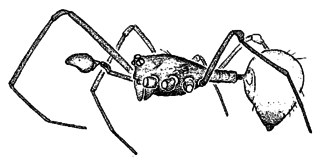
Latrodectus is a broadly distributed genus of spiders with several species that, together, are referred to as true widows. This group is composed of those often loosely called black widow spiders, brown widow spiders, and similar spiders. However, such general "common names" are of limited use as the diversity of species is much greater. A member of the family Theridiidae, this genus contains 32 species, which include several North American "black widows". In addition to these in North America are also the red widow Latrodectus bishopi and the brown widow Latrodectus geometricus, which, in addition to North America, has a much wider geographic distribution. Elsewhere, others include the European black widow, the Australian redback black widow, several different species in Southern Africa that can be called Button spiders, and the South American black widow spiders. Species vary widely in size. In most cases, the females are dark-coloured, but some may have lighter bodies or even reddish. Many can have red, white or brown markings on the upper-side (dorsal) of the abdomen. Some can be readily identifiable by reddish markings on the central underside (ventral) abdomen, which are often hourglass-shaped.

Theridiidae, also known as the tangle-web spiders, cobweb spiders and comb-footed spiders, is a large family of araneomorph spiders first described by Carl Jakob Sundevall in 1833. This diverse, globally distributed family includes over 3,000 species in 124 genera, and is the most common arthropod found in human dwellings throughout the world.

Latrodectus bishopi is the scientific name for the red widow spider, which is endemic to certain habitats of central and southern Florida, where it lives primarily in sand dunes dominated by sand pine, Pinus clausa – a type of vegetation found only in peninsular Florida.

Steatoda grossa, commonly known as the cupboard spider, the dark comb-footed spider, the brown house spider, or the false widow, is a common species of spider in the genus Steatoda.

Styposis is a genus of comb-footed spiders that was first described by Eugène Louis Simon in 1894. It is a senior synonym of Cyatholipulus.

Cerocida is a spider genus known only from tropical South America.

Wirada is a genus of comb-footed spiders that was first described by Eugen von Keyserling in 1886.

The spider genus Spintharus occurs from the northeastern United States to Brazil. Nicholas Marcellus Hentz circumscribed the genus in 1850, initially as a monospecific genus containing his newly described species S. flavidus.

Stemmops is a genus of comb-footed spiders that was first described by Octavius Pickard-Cambridge in 1894.

Chrosiothes is a genus of comb-footed spiders that was first described by Eugène Louis Simon in 1894. It is considered a senior synonym of Theridiotis.

Anatea formicaria is an ant-mimicking spider. It is only known from the rain forest of New Caledonia. Before 1967, it was considered to belong to the family Clubionidae. It was placed there based on the ant-like outward modifications and male genitalia, which superficially resemble those of the genus Micaria. In fact it is closely related to the genera Euryopis and possibly Achaearanea.
Paratheridula is a monotypic genus of comb-footed spiders containing the single species, Paratheridula perniciosa. The sole species was first described in 1886 under the name Theridion perniciosum. The genus was first described by Herbert Walter Levi in 1957, though it has been described under several different names, including Mysmena 4-maculata, Theridion quadrimaculatum, and Theridion arcadicum,

Theridula is a genus of cobweb spiders, found in many parts of the world. Species vary in size from 1 to 3.5 mm in length.

Zygoballus sexpunctatus is a species of jumping spider which occurs in the southeastern United States where it can be found in a variety of grassy habitats. Adult spiders measure between 3 and 4.5 mm in length. The cephalothorax and abdomen are bronze to black in color, with reddish brown or yellowish legs. The male has distinctive enlarged chelicerae and front femora. Like many jumping spiders, Z. sexpunctatus males exhibit ritualized courtship and agonistic behavior.

Rugathodes sexpunctatus is a minute species of spider in the family Theridiidae, the cobweb or tangle-web spiders. This family includes the medically important genus Latrodectus—the widow spiders. The species in the genus Rugathodes are too small to be dangerous to humans. Very little is known about most species in this genus.
Anelosimus jabaquara is a species of spider found in subtropical, humid, lowland forests in Brazil. Anelosimus jabaquara was first described by Herbert W. Levi in 1956. These spiders cooperate to spin and repair the colonial web, capture prey, and care for the brood. Colony size is small, and the sex ratio is biased towards females.
Jamaitidion is a monotypic genus of comb-footed spiders containing the single species, Jamaitidion jamaicense. The genus was first described by J. Wunderlich in 1995, and is found on the Greater Antilles. The sole species of this genus was described by Herbert Walter Levi in 1959. It was originally placed in Theridion, but was moved to its own genus based on unique features of the epigynum.
Spintharus berniesandersi is a species of Spintharus in the family Theridiidae. It is endemic to Cuba.
Mastophora extraordinaria is a species of spider in the orb-weaver spider family Araneidae. It is found in South America. Like some other species of the genus Mastophora, adult females resemble bird droppings. Mastophora species, including M. extraordinaria, are "bolas spiders" – adult females capture their prey by using a sticky drop on the end of a single line which they swing at the target, usually a male moth attracted by the release of an analogue of the attractant sex pheromone produced by the female moth. Juveniles and adult males do not use a bolas, catching prey with their legs alone.
Cladomelea akermani is a species of spider in the orb-weaver spider family Araneidae, found in South Africa. Cladomelea species, including C. akermani, are "bolas spiders" – adult females capture their prey by using a sticky drop on the end of a single line which they swing, usually catching male moths attracted by the release of an analogue of the attractant sex pheromone produced by the female moth. Juvenile and adult male bolas spiders do not use a bolas, catching prey with their legs alone.















